Overview
- Brief Narrative
- Poster stamp issued and distributed in 1942 by the American Federation for Polish Jews. Although they were not valid for postage, poster stamps could be affixed to letters and envelopes as fund-raising, propaganda, and educational tools. The American Federation for Polish Jews was founded in 1908 in New York City as the Federation of Russian-Polish Hebrews, and changed their name in the 1920s. During the Holocaust, the American Federation coordinated with the World Federation to provide relief and assistance to Jews living in Poland. Despite the promise printed on the stamp to not turn their back on European Jews, the United States government made it increasingly difficult for refugees to enter the country. Prior to entering the war in 1941, the State Department feared infiltration and espionage, and required multiple moral and financial affidavits in addition to a number of other documents for those wishing to enter the country. Additionally, they maintained a strict quota system, which restricted the number of visas granted each year. Fleeing Europe became even more difficult in July 1941 when U.S. consulates closed in Nazi-occupied territories, including Poland.
- Date
-
issue:
1942
- Geography
-
issue:
New York (N.Y.)
distribution: United States.
- Credit Line
- United States Holocaust Memorial Museum collection, gift of Gregg and Michelle Philipson
- Markings
- front, top, printed, white : AMERICA / WILL NOT / FORSAKE YOU
front, bottom, printed, white : AMERICAN FEDERATION / for POLISH JEWS - Signature
- front, lower right corner, within image, printed, brown ink : [illegible] / UWB
- Contributor
-
Distributor:
American Federation for Polish Jews
Physical Details
- Language
- English
- Classification
-
Posters
- Category
-
Anti-Nazi propaganda
- Object Type
-
Poster stamps (lcsh)
- Genre/Form
- Stamps.
- Physical Description
- Rectangular poster stamp on cream paper with a brown and light green printed image. The bottom edge is unperforated. The image in the center features a family of three with a silhouette of the Statue of Liberty, overlaying a light green background. In the back is a man wearing a dark brimmed hat and dark coat, facing towards the right, and with his left hand raised in a wave. In front of him is a woman wearing a dark coat and a light-colored headscarf tied under her chin. She is clutching her hands, and facing towards the viewer. On the right is a young boy wearing a pageboy cap and coat, facing the statue with his right hand raised and pointing. In the lower right corner of the image is a marking. The slogan is printed in a brown rectangle at the top and the distributing organization is printed in a brown rectangle below the image. There is no adhesive on the back.
- Dimensions
- overall: Height: 1.750 inches (4.445 cm) | Width: 1.000 inches (2.54 cm)
- Materials
- overall : paper, ink
Rights & Restrictions
- Conditions on Access
- No restrictions on access
- Conditions on Use
- No restrictions on use
Keywords & Subjects
Administrative Notes
- Legal Status
- Permanent Collection
- Provenance
- The stamp was donated to the United States Holocaust Memorial Museum in 2017 by Gregg Philipson.
- Record last modified:
- 2024-01-16 14:17:59
- This page:
- https://collections.ushmm.org/search/catalog/irn562745
Download & Licensing
In-Person Research
- By Appointment
- Request 21 Days in Advance of Visit
- Plan a Research Visit
- Request to See This Object
Contact Us
Also in Gregg and Michelle Philipson Collection and Archive
The collection consists of poster stamps and a letter relating to the United States and Poland before, during, and after the Holocaust.
Date: after 1933 May-1947 November 22
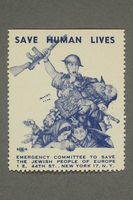
US poster stamp encouraging people to donate to a humanitarian organization
Object
Poster stamp issued and distributed in 1944 by the Emergency Committee to Save the Jewish People of Europe. The design is copied from a piece entitled, “Tears of Rage,” created in 1942 by Jewish artist, Arthur Szyk, to develop public interest in the Committee’s humanitarian efforts. The image depicts a Jewish soldier angered at the murder and suffering of Jews by the Nazis. Szyk was himself an immigrant born in Łódź, Poland, and lost his mother in the Holocaust. The mission of the Committee was a personal cause for Szyk, and he became one of the founding members. Although they were not valid for postage, poster stamps could be affixed to letters and envelopes as fund-raising, propaganda, and educational tools. The Emergency Committee to Save the Jewish People of Europe was founded in 1943 by Peter H. Bergson (pseudonym for Hillel Kook) and other young Jewish activists. The Committee formed in reaction to the first verified information of the Holocaust that reached the United States. On July 20, 1943, the group held the Emergency Conference in New York City, bringing together 1,500 delegates. The Committee was replaced by the American League for a Free Palestine in 1945.

US poster stamp encouraging people to donate to a humanitarian organization
Object
Second-issue poster stamp, issued and distributed in 1944 by the Emergency Committee to Save the Jewish People of Europe. The design is copied from a piece entitled “Tears of Rage,” created by Jewish artist Arthur Szyk in 1942 and used to create public interest in the Committee’s humanitarian efforts. The image depicts a Jewish soldier angered at the murder and suffering of Jews by the Nazis. Szyk was himself an immigrant born in Łódź, Poland, and lost his mother in the Holocaust. The mission of the Committee was a personal cause for Szyk, and he became one of the founding members. Although they were not valid for postage, poster stamps could be affixed to letters and envelopes as fund-raising, propaganda, and educational tools. The Emergency Committee to Save the Jewish People of Europe was co-founded in 1943 by Peter H. Bergson (pseudonym for Hillel Kook) and other young Jewish activists. The Committee formed in reaction to the first verified information of the Holocaust that reached the United States. On July 20, 1943, the group held the Emergency Conference in New York City, bringing together 1,500 delegates. The Committee was replaced by the American League for a Free Palestine in 1945.

US poster stamp encouraging people to donate to a humanitarian organization
Object
Second-issue poster stamp, issued and distributed in 1944 by the Emergency Committee to Save the Jewish People of Europe. The design is copied from a piece entitled “Tears of Rage,” created by Jewish artist Arthur Szyk in 1942 and used to create public interest in the Committee’s humanitarian efforts. The image depicts a Jewish soldier angered at the murder and suffering of Jews by the Nazis. Szyk was himself an immigrant born in Łódź, Poland, and lost his mother in the Holocaust. The mission of the Committee was a personal cause for Szyk, and he became one of the founding members. Although they were not valid for postage, poster stamps could be affixed to letters and envelopes as fund-raising, propaganda, and educational tools. The Emergency Committee to Save the Jewish People of Europe was co-founded in 1943 by Peter H. Bergson (pseudonym for Hillel Kook) and other young Jewish activists. The Committee formed in reaction to the first verified information of the Holocaust that reached the United States. On July 20, 1943, the group held the Emergency Conference in New York City, bringing together 1,500 delegates. The Committee was replaced by the American League for a Free Palestine in 1945.
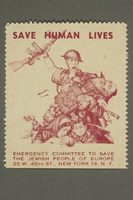
US poster stamp encouraging people to donate to a humanitarian organization
Object
Second-issue poster stamp, issued and distributed in 1944 by the Emergency Committee to Save the Jewish People of Europe. The design is copied from a piece entitled “Tears of Rage,” created by Jewish artist Arthur Szyk in 1942 and used to create public interest in the Committee’s humanitarian efforts. The image depicts a Jewish soldier angered at the murder and suffering of Jews by the Nazis. Szyk was himself an immigrant born in Łódź, Poland, and lost his mother in the Holocaust. The mission of the Committee was a personal cause for Szyk, and he became one of the founding members. Although they were not valid for postage, poster stamps could be affixed to letters and envelopes as fund-raising, propaganda, and educational tools. The Emergency Committee to Save the Jewish People of Europe was co-founded in 1943 by Peter H. Bergson (pseudonym for Hillel Kook) and other young Jewish activists. The Committee formed in reaction to the first verified information of the Holocaust that reached the United States. On July 20, 1943, the group held the Emergency Conference in New York City, bringing together 1,500 delegates. The Committee was replaced by the American League for a Free Palestine in 1945.

US poster stamp encouraging people to donate to a humanitarian organization
Object
First-issue poster stamp, distributed in 1944 by the Emergency Committee to Save the Jewish People of Europe. The design is copied from a piece entitled, “Modern Moses,” created in 1943 by Jewish artist, Arthur Szyk, to develop public interest in the Committee’s humanitarian efforts. The image depicts Moses, a role model for the Zionist movement. He is flanked by a Jewish soldier prepared to fight, and an industrial worker, ready to contribute to the war economy. All three figures serve as inspiration for American Jews to make their own contributions to the war effort. Szyk was himself an immigrant born in Łódź, Poland, and lost his mother in the Holocaust. The mission of the Committee was a personal cause for Szyk, and he became one of the founding members. Although they were not valid for postage, poster stamps could be affixed to letters and envelopes as fund-raising, propaganda, and educational tools. The Emergency Committee to Save the Jewish People of Europe was founded in 1943 by Peter H. Bergson (pseudonym for Hillel Kook) and other young Jewish activists. The Committee formed in reaction to the first verified information of the Holocaust that reached the United States. On July 20, 1943, the group held the Emergency Conference in New York City, bringing together 1,500 delegates. The Committee was replaced by the American League for a Free Palestine in 1945.

US poster stamp encouraging people to donate to a humanitarian organization
Object
First-issue poster stamp, distributed in 1944 by the Emergency Committee to Save the Jewish People of Europe. The design is copied from a piece entitled, “Modern Moses,” created in 1943 by Jewish artist, Arthur Szyk, to develop public interest in the Committee’s humanitarian efforts. The image depicts Moses, a role model for the Zionist movement. He is flanked by a Jewish soldier prepared to fight, and an industrial worker, ready to contribute to the war economy. All three figures serve as inspiration for American Jews to make their own contributions to the war effort. Szyk was himself an immigrant born in Łódź, Poland, and lost his mother in the Holocaust. The mission of the Committee was a personal cause for Szyk, and he became one of the founding members. Although they were not valid for postage, poster stamps could be affixed to letters and envelopes as fund-raising, propaganda, and educational tools. The Emergency Committee to Save the Jewish People of Europe was founded in 1943 by Peter H. Bergson (pseudonym for Hillel Kook) and other young Jewish activists. The Committee formed in reaction to the first verified information of the Holocaust that reached the United States. On July 20, 1943, the group held the Emergency Conference in New York City, bringing together 1,500 delegates. The Committee was replaced by the American League for a Free Palestine in 1945.

US poster stamp encouraging people to donate to a humanitarian organization
Object
First-issue poster stamp, distributed in 1944 by the Emergency Committee to Save the Jewish People of Europe. The design is copied from a piece entitled, “Modern Moses,” created in 1943 by Jewish artist, Arthur Szyk, to develop public interest in the Committee’s humanitarian efforts. The image depicts Moses, a role model for the Zionist movement. He is flanked by a Jewish soldier prepared to fight, and an industrial worker, ready to contribute to the war economy. All three figures serve as inspiration for American Jews to make their own contributions to the war effort. Szyk was himself an immigrant born in Łódź, Poland, and lost his mother in the Holocaust. The mission of the Committee was a personal cause for Szyk, and he became one of the founding members. Although they were not valid for postage, poster stamps could be affixed to letters and envelopes as fund-raising, propaganda, and educational tools. The Emergency Committee to Save the Jewish People of Europe was founded in 1943 by Peter H. Bergson (pseudonym for Hillel Kook) and other young Jewish activists. The Committee formed in reaction to the first verified information of the Holocaust that reached the United States. On July 20, 1943, the group held the Emergency Conference in New York City, bringing together 1,500 delegates. The Committee was replaced by the American League for a Free Palestine in 1945.
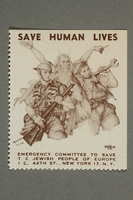
US poster stamp encouraging people to donate to a humanitarian organization
Object
First-issue poster stamp, distributed in 1944 by the Emergency Committee to Save the Jewish People of Europe. The design is copied from a piece entitled, “Modern Moses,” created in 1943 by Jewish artist, Arthur Szyk, to develop public interest in the Committee’s humanitarian efforts. The image depicts Moses, a role model for the Zionist movement. He is flanked by a Jewish soldier prepared to fight, and an industrial worker, ready to contribute to the war economy. All three figures serve as inspiration for American Jews to make their own contributions to the war effort. Szyk was himself an immigrant born in Łódź, Poland, and lost his mother in the Holocaust. The mission of the Committee was a personal cause for Szyk, and he became one of the founding members. Although they were not valid for postage, poster stamps could be affixed to letters and envelopes as fund-raising, propaganda, and educational tools. The Emergency Committee to Save the Jewish People of Europe was founded in 1943 by Peter H. Bergson (pseudonym for Hillel Kook) and other young Jewish activists. The Committee formed in reaction to the first verified information of the Holocaust that reached the United States. On July 20, 1943, the group held the Emergency Conference in New York City, bringing together 1,500 delegates. The Committee was replaced by the American League for a Free Palestine in 1945.
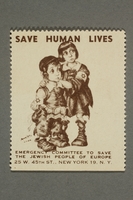
US poster stamp encouraging people to donate to a humanitarian organization
Object
Second-issue poster stamp, distributed in 1944 by the Emergency Committee to Save the Jewish People of Europe. The design, featuring two frightened Jewish children, is an excerpt from a piece entitled, “To Be Shot, as Dangerous Enemies of the Third Reich…" It was created in 1943 by Jewish artist, Arthur Szyk, to develop public interest in the Committee’s humanitarian efforts. The full drawing depicts the children standing before a tribunal from the German Wehrmacht. Szyk was himself an immigrant born in Łódź, Poland, and lost his mother in the Holocaust. The mission of the Committee was a personal cause for Szyk, and he became one of the founding members. Although they were not valid for postage, poster stamps could be affixed to letters and envelopes as fund-raising, propaganda, and educational tools. The Emergency Committee to Save the Jewish People of Europe was founded in 1943 by Peter H. Bergson (pseudonym for Hillel Kook) and other young Jewish activists. The Committee formed in reaction to the first verified information of the Holocaust that reached the United States. On July 20, 1943, the group held the Emergency Conference in New York City, bringing together 1,500 delegates. The Committee was replaced by the American League for a Free Palestine in 1945.
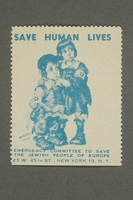
US poster stamp encouraging people to donate to a humanitarian organization
Object
Second-issue poster stamp, distributed in 1944 by the Emergency Committee to Save the Jewish People of Europe. The design, featuring two frightened Jewish children, is an excerpt from a piece entitled, “To Be Shot, as Dangerous Enemies of the Third Reich…" It was created in 1943 by Jewish artist, Arthur Szyk, to develop public interest in the Committee’s humanitarian efforts. The full drawing depicts the children standing before a tribunal from the German Wehrmacht. Szyk was himself an immigrant born in Łódź, Poland, and lost his mother in the Holocaust. The mission of the Committee was a personal cause for Szyk, and he became one of the founding members. Although they were not valid for postage, poster stamps could be affixed to letters and envelopes as fund-raising, propaganda, and educational tools. The Emergency Committee to Save the Jewish People of Europe was founded in 1943 by Peter H. Bergson (pseudonym for Hillel Kook) and other young Jewish activists. The Committee formed in reaction to the first verified information of the Holocaust that reached the United States. On July 20, 1943, the group held the Emergency Conference in New York City, bringing together 1,500 delegates. The Committee was replaced by the American League for a Free Palestine in 1945.
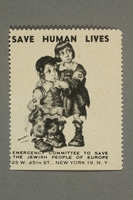
US poster stamp encouraging people to donate to a humanitarian organization
Object
Second-issue poster stamp, distributed in 1944 by the Emergency Committee to Save the Jewish People of Europe. The design, featuring two frightened Jewish children, is an excerpt from a piece entitled, “To Be Shot, as Dangerous Enemies of the Third Reich…” It was created in 1943 by Jewish artist, Arthur Szyk, to develop public interest in the Committee’s humanitarian efforts. The full drawing depicts the children standing before a tribunal from the German Wehrmacht. Szyk was himself an immigrant born in Łódź, Poland, and lost his mother in the Holocaust. The mission of the Committee was a personal cause for Szyk, and he became one of the founding members. Although they were not valid for postage, poster stamps could be affixed to letters and envelopes as fund-raising, propaganda, and educational tools. The Emergency Committee to Save the Jewish People of Europe was founded in 1943 by Peter H. Bergson (pseudonym for Hillel Kook) and other young Jewish activists. The Committee formed in reaction to the first verified information of the Holocaust that reached the United States. On July 20, 1943, the group held the Emergency Conference in New York City, bringing together 1,500 delegates. The Committee was replaced by the American League for a Free Palestine in 1945.

US poster stamp encouraging people to donate to a humanitarian organization
Object
Second-issue poster stamp, distributed in 1944 by the Emergency Committee to Save the Jewish People of Europe. The design, featuring two frightened Jewish children, is an excerpt from a piece entitled, “To Be Shot, as Dangerous Enemies of the Third Reich…” It was created in 1943 by Jewish artist, Arthur Szyk, to develop public interest in the Committee’s humanitarian efforts. The full drawing depicts the children standing before a tribunal from the German Wehrmacht. Szyk was himself an immigrant born in Łódź, Poland, and lost his mother in the Holocaust. The mission of the Committee was a personal cause for Szyk, and he became one of the founding members. Although they were not valid for postage, poster stamps could be affixed to letters and envelopes as fund-raising, propaganda, and educational tools. The Emergency Committee to Save the Jewish People of Europe was founded in 1943 by Peter H. Bergson (pseudonym for Hillel Kook) and other young Jewish activists. The Committee formed in reaction to the first verified information of the Holocaust that reached the United States. On July 20, 1943, the group held the Emergency Conference in New York City, bringing together 1,500 delegates. The Committee was replaced by the American League for a Free Palestine in 1945.

US poster stamp encouraging people to donate to a humanitarian organization
Object
Poster stamp issued and distributed in 1944 by the Emergency Committee to Save the Jewish People of Europe. The design was created by the Jewish artist, Arthur Szyk, and used to develop public interest in the Committee’s humanitarian efforts. Szyk was himself an immigrant born in Łódź, Poland, and lost his mother in the Holocaust. The mission of the Committee was a personal cause for Szyk, and he became one of the founding members. Although they were not valid for postage, poster stamps could be affixed to letters and envelopes as fund-raising, propaganda, and educational tools. The Emergency Committee to Save the Jewish People of Europe was founded in 1943 by Peter H. Bergson (pseudonym for Hillel Kook) and other young Jewish activists. The Committee formed in reaction to the first verified information of the Holocaust that reached the United States. On July 20, 1943, the group held the Emergency Conference in New York City, bringing together 1,500 delegates. The Committee was replaced by the American League for a Free Palestine in 1945.
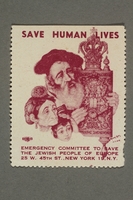
US poster stamp encouraging people to donate to a humanitarian organization
Object
Second-issue poster stamp issued and distributed in May 1944 by the Emergency Committee to Save the Jewish People of Europe. The design was created by the Jewish artist, Arthur Szyk, and used to develop public interest in the Committee’s humanitarian efforts. Szyk was himself an immigrant born in Łódź, Poland, and lost his mother in the Holocaust. The mission of the Committee was a personal cause for Szyk, and he became one of the founding members. Although they were not valid for postage, poster stamps could be affixed to letters and envelopes as fund-raising, propaganda, and educational tools. The Emergency Committee to Save the Jewish People of Europe was founded in 1943 by Peter H. Bergson (pseudonym for Hillel Kook) and other young Jewish activists. The Committee formed in reaction to the first verified information of the Holocaust that reached the United States. On July 20, 1943, the group held the Emergency Conference in New York City, bringing together 1,500 delegates. The Committee was replaced by the American League for a Free Palestine in 1945.

US poster stamp encouraging people to donate to a humanitarian organization
Object
Poster stamp issued and distributed in 1944 by the Emergency Committee to Save the Jewish People of Europe. The design was created by the Jewish artist, Arthur Szyk, and used to develop public interest in the Committee’s humanitarian efforts. Szyk was himself an immigrant born in Łódź, Poland, and lost his mother in the Holocaust. The mission of the Committee was a personal cause for Szyk, and he became one of the founding members. Although they were not valid for postage, poster stamps could be affixed to letters and envelopes as fund-raising, propaganda, and educational tools. The Emergency Committee to Save the Jewish People of Europe was founded in 1943 by Peter H. Bergson (pseudonym for Hillel Kook) and other young Jewish activists. The Committee formed in reaction to the first verified information of the Holocaust that reached the United States. On July 20, 1943, the group held the Emergency Conference in New York City, bringing together 1,500 delegates. The Committee was replaced by the American League for a Free Palestine in 1945.
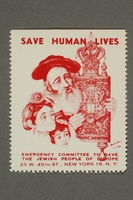
US poster stamp encouraging people to donate to a humanitarian organization
Object
Second-issue poster stamp issued and distributed in May 1944 by the Emergency Committee to Save the Jewish People of Europe. The design was created by the Jewish artist, Arthur Szyk, and used to create public interest in the Committee’s humanitarian efforts. Szyk was himself an immigrant born in Łódź, Poland, and lost his mother in the Holocaust. The mission of the Committee was a personal cause for Szyk, and he became one of the founding members. Although they were not valid for postage, poster stamps could be affixed to letters and envelopes as fund-raising, propaganda, and educational tools. The Emergency Committee to Save the Jewish People of Europe was founded in 1943 by Peter H. Bergson (pseudonym for Hillel Kook) and other young Jewish activists. The Committee formed in reaction to the first verified information of the Holocaust that reached the United States. On July 20, 1943, the group held the Emergency Conference in New York City, bringing together 1,500 delegates. The Committee was replaced by the American League for a Free Palestine in 1945.
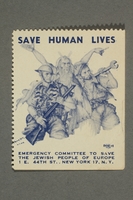
US poster stamp encouraging people to donate to a humanitarian organization
Object
First-issue poster stamp, distributed in 1944 by the Emergency Committee to Save the Jewish People of Europe. The design is copied from a piece entitled “Modern Moses,” created in 1943 by Jewish artist, Arthur Szyk, to develop public interest in the Committee’s humanitarian efforts. The image depicts Moses, a role model for the Zionist movement. He is flanked by a Jewish soldier prepared to fight, and an industrial worker, ready to contribute to the war economy. All three figures serve as inspiration for American Jews to make their own contributions to the war effort. Szyk was himself an immigrant born in Łódź, Poland, and lost his mother in the Holocaust. The mission of the Committee was a personal cause for Szyk, and he became one of the founding members. Although they were not valid for postage, poster stamps could be affixed to letters and envelopes as fund-raising, propaganda, and educational tools. The Emergency Committee to Save the Jewish People of Europe was founded in 1943 by Peter H. Bergson (pseudonym for Hillel Kook) and other young Jewish activists. The Committee formed in reaction to the first verified information of the Holocaust that reached the United States. On July 20, 1943, the group held the Emergency Conference in New York City, bringing together 1,500 delegates. The Committee was replaced by the American League for a Free Palestine in 1945.
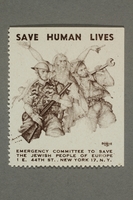
US poster stamp encouraging people to donate to a humanitarian organization
Object
First-issue poster stamp, distributed in 1944 by the Emergency Committee to Save the Jewish People of Europe. The design is copied from a piece entitled “Modern Moses,” created in 1943 by Jewish artist, Arthur Szyk, to develop public interest in the Committee’s humanitarian efforts. The image depicts Moses, a role model for the Zionist movement. He is flanked by a Jewish soldier prepared to fight, and an industrial worker, ready to contribute to the war economy. All three figures serve as inspiration for American Jews to make their own contributions to the war effort. Szyk was himself an immigrant born in Łódź, Poland, and lost his mother in the Holocaust. The mission of the Committee was a personal cause for Szyk, and he became one of the founding members. Although they were not valid for postage, poster stamps could be affixed to letters and envelopes as fund-raising, propaganda, and educational tools. The Emergency Committee to Save the Jewish People of Europe was founded in 1943 by Peter H. Bergson (pseudonym for Hillel Kook) and other young Jewish activists. The Committee formed in reaction to the first verified information of the Holocaust that reached the United States. On July 20, 1943, the group held the Emergency Conference in New York City, bringing together 1,500 delegates. The Committee was replaced by the American League for a Free Palestine in 1945.

US poster stamp encouraging people to donate to a humanitarian organization
Object
Second-issue poster stamp, distributed in 1944 by the Emergency Committee to Save the Jewish People of Europe. The design, featuring two frightened Jewish children, is an excerpt from a piece entitled “To Be Shot, as Dangerous Enemies of the Third Reich…,” created in 1943 by Jewish artist, Arthur Szyk, to develop public interest in the Committee’s humanitarian efforts. The full drawing depicts the children standing before a tribunal from the German Wehrmacht. Szyk was himself an immigrant born in Łódź, Poland, and lost his mother in the Holocaust. The mission of the Committee was a personal cause for Szyk, and he became one of the founding members. Although they were not valid for postage, poster stamps could be affixed to letters and envelopes as fund-raising, propaganda, and educational tools. The Emergency Committee to Save the Jewish People of Europe was founded in 1943 by Peter H. Bergson (pseudonym for Hillel Kook) and other young Jewish activists. The Committee formed in reaction to the first verified information of the Holocaust that reached the United States. On July 20, 1943, the group held the Emergency Conference in New York City, bringing together 1,500 delegates. The Committee was replaced by the American League for a Free Palestine in 1945.
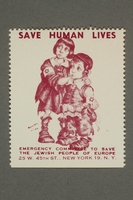
US poster stamp encouraging people to donate to a humanitarian organization
Object
Second-issue poster stamp, distributed in 1944 by the Emergency Committee to Save the Jewish People of Europe. The design, featuring two frightened Jewish children, is an excerpt from a piece entitled “To Be Shot, as Dangerous Enemies of the Third Reich…,” created in 1943 by Jewish artist, Arthur Szyk, to develop public interest in the Committee’s humanitarian efforts. The full drawing depicts the children standing before a tribunal from the German Wehrmacht. Szyk was himself an immigrant born in Łódź, Poland, and lost his mother in the Holocaust. The mission of the Committee was a personal cause for Szyk, and he became one of the founding members. Although they were not valid for postage, poster stamps could be affixed to letters and envelopes as fund-raising, propaganda, and educational tools. The Emergency Committee to Save the Jewish People of Europe was founded in 1943 by Peter H. Bergson (pseudonym for Hillel Kook) and other young Jewish activists. The Committee formed in reaction to the first verified information of the Holocaust that reached the United States. On July 20, 1943, the group held the Emergency Conference in New York City, bringing together 1,500 delegates. The Committee was replaced by the American League for a Free Palestine in 1945.
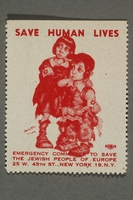
US poster stamp encouraging people to donate to a humanitarian organization
Object
Second-issue poster stamp, distributed in 1944 by the Emergency Committee to Save the Jewish People of Europe. The design, featuring two frightened Jewish children, is an excerpt from a piece entitled “To Be Shot, as Dangerous Enemies of the Third Reich…,” created in1943 by Jewish artist, Arthur Szyk, to develop public interest in the Committee’s humanitarian efforts. The full drawing depicts the children standing before a tribunal from the German Wehrmacht. Szyk was himself an immigrant born in Łódź, Poland, and lost his mother in the Holocaust. The mission of the Committee was a personal cause for Szyk, and he became one of the founding members. Although they were not valid for postage, poster stamps could be affixed to letters and envelopes as fund-raising, propaganda, and educational tools. The Emergency Committee to Save the Jewish People of Europe was founded in 1943 by Peter H. Bergson (pseudonym for Hillel Kook) and other young Jewish activists. The Committee formed in reaction to the first verified information of the Holocaust that reached the United States. On July 20, 1943, the group held the Emergency Conference in New York City, bringing together 1,500 delegates. The Committee was replaced by the American League for a Free Palestine in 1945.
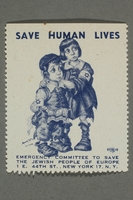
US poster stamp encouraging people to donate to a humanitarian organization
Object
Poster stamp issued and distributed in 1944 by the Emergency Committee to Save the Jewish People of Europe. The design, featuring two frightened Jewish children, is an excerpt from a piece entitled “To Be Shot, as Dangerous Enemies of the Third Reich…,” created in1943 by Jewish artist, Arthur Szyk, to develop public interest in the Committee’s humanitarian efforts. The full drawing depicts the children standing before a tribunal from the German Wehrmacht. Szyk was himself an immigrant born in Łódź, Poland, and lost his mother in the Holocaust. The mission of the Committee was a personal cause for Szyk, and he became one of the founding members. Although they were not valid for postage, poster stamps could be affixed to letters and envelopes as fund-raising, propaganda, and educational tools. The Emergency Committee to Save the Jewish People of Europe was founded in 1943 by Peter H. Bergson (pseudonym for Hillel Kook) and other young Jewish activists. The Committee formed in reaction to the first verified information of the Holocaust that reached the United States. On July 20, 1943, the group held the Emergency Conference in New York City, bringing together 1,500 delegates. The Committee was replaced by the American League for a Free Palestine in 1945.

US poster stamp encouraging people to donate to a humanitarian organization
Object
Poster stamp issued and distributed in 1944 by the Emergency Committee to Save the Jewish People of Europe. The design is copied from a piece entitled “Tears of Rage,” created in 1943 by Jewish artist, Arthur Szyk, to develop public interest in the Committee’s humanitarian efforts. The image depicts a Jewish soldier angered at the murder and suffering of Jews by the Nazis. Szyk was himself an immigrant born in Łódź, Poland, and lost his mother in the Holocaust. The mission of the Committee was a personal cause for Szyk, and he became one of the founding members. Although they were not valid for postage, poster stamps could be affixed to letters and envelopes as fund-raising, propaganda, and educational tools. The Emergency Committee to Save the Jewish People of Europe was founded in 1943 by Peter H. Bergson (pseudonym for Hillel Kook) and other young Jewish activists. The Committee formed in reaction to the first verified information of the Holocaust that reached the United States. On July 20, 1943, the group held the Emergency Conference in New York City, bringing together 1,500 delegates. The Committee was replaced by the American League for a Free Palestine in 1945.

US poster stamp encouraging people to donate to a humanitarian organization
Object
Second-issue poster stamp, issued and distributed in 1944 by the Emergency Committee to Save the Jewish People of Europe. The design is copied from a piece entitled “Tears of Rage,” created in 1943 by Jewish artist, Arthur Szyk, to develop public interest in the Committee’s humanitarian efforts. The image depicts a Jewish soldier angered at the murder and suffering of Jews by the Nazis. Szyk was himself an immigrant born in Łódź, Poland, and lost his mother in the Holocaust. The mission of the Committee was a personal cause for Szyk, and he became one of the founding members. Although they were not valid for postage, poster stamps could be affixed to letters and envelopes as fund-raising, propaganda, and educational tools. The Emergency Committee to Save the Jewish People of Europe was co-founded in 1943 by Peter H. Bergson (pseudonym for Hillel Kook) and other young Jewish activists. The Committee formed in reaction to the first verified information of the Holocaust that reached the United States. On July 20, 1943, the group held the Emergency Conference in New York City, bringing together 1,500 delegates. The Committee was replaced by the American League for a Free Palestine in 1945.
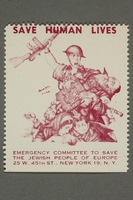
US poster stamp encouraging people to donate to a humanitarian organization
Object
Second-issue poster stamp, issued and distributed in 1944 by the Emergency Committee to Save the Jewish People of Europe. The design is copied from a piece entitled “Tears of Rage,” created in 1943 by Jewish artist, Arthur Szyk, to develop public interest in the Committee’s humanitarian efforts. The image depicts a Jewish soldier angered at the murder and suffering of Jews by the Nazis. Szyk was himself an immigrant born in Łódź, Poland, and lost his mother in the Holocaust. The mission of the Committee was a personal cause for Szyk, and he became one of the founding members. Although they were not valid for postage, poster stamps could be affixed to letters and envelopes as fund-raising, propaganda, and educational tools. The Emergency Committee to Save the Jewish People of Europe was co-founded in 1943 by Peter H. Bergson (pseudonym for Hillel Kook) and other young Jewish activists. The Committee formed in reaction to the first verified information of the Holocaust that reached the United States. On July 20, 1943, the group held the Emergency Conference in New York City, bringing together 1,500 delegates. The Committee was replaced by the American League for a Free Palestine in 1945.
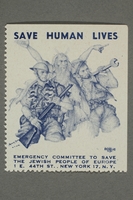
US poster stamp encouraging people to donate to a humanitarian organization
Object
First-issue poster stamp, distributed in 1944 by the Emergency Committee to Save the Jewish People of Europe. The design is copied from a piece entitled “Modern Moses,” created in 1943 by Jewish artist, Arthur Szyk, to develop public interest in the Committee’s humanitarian efforts. The image depicts Moses, a role model for the Zionist movement. He is flanked by a Jewish soldier prepared to fight, and an industrial worker, ready to contribute to the war economy. All three figures serve as inspiration for American Jews to make their own contributions to the war effort. Szyk was himself an immigrant born in Łódź, Poland, and lost his mother in the Holocaust. The mission of the Committee was a personal cause for Szyk, and he became one of the founding members. Although they were not valid for postage, poster stamps could be affixed to letters and envelopes as fund-raising, propaganda, and educational tools. The Emergency Committee to Save the Jewish People of Europe was founded in 1943 by Peter H. Bergson (pseudonym for Hillel Kook) and other young Jewish activists. The Committee formed in reaction to the first verified information of the Holocaust that reached the United States. On July 20, 1943, the group held the Emergency Conference in New York City, bringing together 1,500 delegates. The Committee was replaced by the American League for a Free Palestine in 1945.
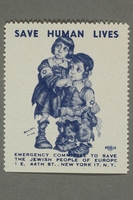
US poster stamp encouraging people to donate to a humanitarian organization
Object
Poster stamp issued and distributed in 1944 by the Emergency Committee to Save the Jewish People of Europe. The design, featuring two frightened Jewish children, is an excerpt from a piece entitled “To Be Shot, as Dangerous Enemies of the Third Reich…,” created in 1943 by Jewish artist, Arthur Szyk, to develop public interest in the Committee’s humanitarian efforts. The full drawing depicts the children standing before a tribunal from the German Wehrmacht. Szyk was himself an immigrant born in Łódź, Poland, and lost his mother in the Holocaust. The mission of the Committee was a personal cause for Szyk, and he became one of the founding members. Although they were not valid for postage, poster stamps could be affixed to letters and envelopes as fund-raising, propaganda, and educational tools. The Emergency Committee to Save the Jewish People of Europe was founded in 1943 by Peter H. Bergson (pseudonym for Hillel Kook) and other young Jewish activists. The Committee formed in reaction to the first verified information of the Holocaust that reached the United States. On July 20, 1943, the group held the Emergency Conference in New York City, bringing together 1,500 delegates. The Committee was replaced by the American League for a Free Palestine in 1945.
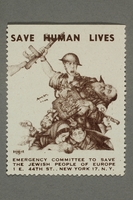
US poster stamp encouraging people to donate to a humanitarian organization
Object
Poster stamp issued and distributed in 1944 by the Emergency Committee to Save the Jewish People of Europe. The design is copied from a piece entitled “Tears of Rage,” created in 1942 by Jewish artist, Arthur Szyk, to develop public interest in the Committee’s humanitarian efforts. The image depicts a Jewish soldier angered at the murder and suffering of Jews by the Nazis. Szyk was himself an immigrant born in Łódź, Poland, and lost his mother in the Holocaust. The mission of the Committee was a personal cause for Szyk, and he became one of the founding members. Although they were not valid for postage, poster stamps could be affixed to letters and envelopes as fund-raising, propaganda, and educational tools. The Emergency Committee to Save the Jewish People of Europe was founded in 1943 by Peter H. Bergson (pseudonym for Hillel Kook) and other young Jewish activists. The Committee formed in reaction to the first verified information of the Holocaust that reached the United States. On July 20, 1943, the group held the Emergency Conference in New York City, bringing together 1,500 delegates. The Committee was replaced by the American League for a Free Palestine in 1945.
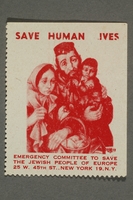
US poster stamp encouraging people to donate to a humanitarian organization
Object
Second-issue poster stamp issued and distributed in May 1944 by the Emergency Committee to Save the Jewish People of Europe. The design was created by the Jewish artist, Arthur Szyk, to develop public interest in the Committee’s humanitarian efforts. Szyk was himself an immigrant born in Łódź, Poland, and lost his mother in the Holocaust. The mission of the Committee was a personal cause for Szyk, and he became one of the founding members. Although they were not valid for postage, poster stamps could be affixed to letters and envelopes as fund-raising, propaganda, and educational tools. The Emergency Committee to Save the Jewish People of Europe was founded in 1943 by Peter H. Bergson (pseudonym for Hillel Kook) and other young Jewish activists. The Committee formed in reaction to the first verified information of the Holocaust that reached the United States. On July 20, 1943, the group held the Emergency Conference in New York City, bringing together 1,500 delegates. The Committee was replaced by the American League for a Free Palestine in 1945.
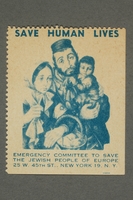
US poster stamp encouraging people to donate to a humanitarian organization
Object
Second-issue poster stamp issued and distributed in May 1944 by the Emergency Committee to Save the Jewish People of Europe. The design was created by the Jewish artist, Arthur Szyk, to develop public interest in the Committee’s humanitarian efforts. Szyk was himself an immigrant born in Łódź, Poland, and lost his mother in the Holocaust. The mission of the Committee was a personal cause for Szyk, and he became one of the founding members. Although they were not valid for postage, poster stamps could be affixed to letters and envelopes as fund-raising, propaganda, and educational tools. The Emergency Committee to Save the Jewish People of Europe was founded in 1943 by Peter H. Bergson (pseudonym for Hillel Kook) and other young Jewish activists. The Committee formed in reaction to the first verified information of the Holocaust that reached the United States. On July 20, 1943, the group held the Emergency Conference in New York City, bringing together 1,500 delegates. The Committee was replaced by the American League for a Free Palestine in 1945.

Set of US poster stamps encouraging people to donate to a humanitarian organization
Object
Partial sheet of poster stamps distributed in 1941 by the American Federation for Polish Jews. The design was created by the Jewish artist, Arthur Szyk, to develop public interest in the Federation’s humanitarian efforts. Szyk was himself an immigrant born in Łódź, Poland, and lost his mother in the Holocaust, making the Federation’s mission a personal cause for him. Although they were not valid for postage, poster stamps could be affixed to letters and envelopes as fund-raising, propaganda, and educational tools. The American Federation for Polish Jews was founded in 1908 in New York City as the Federation of Russian-Polish Hebrews, and changed their name in the 1920s. During the Holocaust, the American Federation coordinated with the World Federation to provide relief and assistance to Jews living in Poland.

US poster stamp encouraging people to donate to a humanitarian organization
Object
Poster stamp distributed in 1942 by the American Federation for Polish Jews. The design was created by the Jewish artist, Arthur Szyk, to develop public interest in the Federation’s humanitarian efforts. Szyk was himself an immigrant born in Łódź, Poland, and lost his mother in the Holocaust, making the Federation’s mission a personal cause for him. Although they were not valid for postage, poster stamps could be affixed to letters and envelopes as fund-raising, propaganda, and educational tools. The American Federation for Polish Jews was founded in 1908 in New York City as the Federation of Russian-Polish Hebrews, and changed their name in the 1920s. During the Holocaust, the American Federation coordinated with the World Federation to provide relief and assistance to Jews living in Poland.
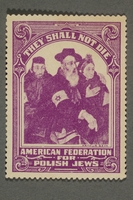
US poster stamp encouraging people to donate to a humanitarian organization
Object
Poster stamp distributed in 1942 by the American Federation for Polish Jews. The design was created by the Jewish artist, Arthur Szyk, to develop public interest in the Federation’s humanitarian efforts. Szyk was himself an immigrant born in Łódź, Poland, and lost his mother in the Holocaust, making the Federation’s mission a personal cause for him. Although they were not valid for postage, poster stamps could be affixed to letters and envelopes as fund-raising, propaganda, and educational tools. The American Federation for Polish Jews was founded in 1908 in New York City as the Federation of Russian-Polish Hebrews, and changed their name in the 1920s. During the Holocaust, the American Federation coordinated with the World Federation to provide relief and assistance to Jews living in Poland.

Set of US poster stamps depicting the Four Freedoms
Object
Poster stamps distributed in 1944 and 1945 by the Emergency Committee to Save the Jewish People of Europe. The designs were copied from works created by Jewish artist, Arthur Szyk, who was inspired by President Roosevelt’s January 1941 State of the Union address (also known as the Four Freedoms Speech), and used to create public interest in the Committee’s humanitarian efforts. Szyk was himself an immigrant born in Łódź, Poland, and lost his mother in the Holocaust. The mission of the Committee was a personal cause for Szyk, and he became one of the founding members. Although they were not valid for postage, poster stamps could be affixed to letters and envelopes as fund-raising, propaganda, and educational tools. The Emergency Committee to Save the Jewish People of Europe was founded in 1943 by Peter H. Bergson (pseudonym for Hillel Kook) and other young Jewish activists. The Committee formed in reaction to the first verified information of the Holocaust that reached the United States. On July 20, 1943, the group held the Emergency Conference in New York City, bringing together 1,500 delegates. The Committee was replaced by the American League for a Free Palestine in 1945.

Set of US poster stamps depicting the Four Freedoms
Object
Poster stamps distributed in 1944 and 1945 by the Emergency Committee to Save the Jewish People of Europe. The designs were copied from works created by Jewish artist, Arthur Szyk, who was inspired by President Roosevelt’s January 1941 State of the Union address (also known as the Four Freedoms Speech), and used to create public interest in the Committee’s humanitarian efforts. Szyk was himself an immigrant born in Łódź, Poland, and lost his mother in the Holocaust. The mission of the Committee was a personal cause for Szyk, and he became one of the founding members. Although they were not valid for postage, poster stamps could be affixed to letters and envelopes as fund-raising, propaganda, and educational tools. The Emergency Committee to Save the Jewish People of Europe was founded in 1943 by Peter H. Bergson (pseudonym for Hillel Kook) and other young Jewish activists. The Committee formed in reaction to the first verified information of the Holocaust that reached the United States. On July 20, 1943, the group held the Emergency Conference in New York City, bringing together 1,500 delegates. The Committee was replaced by the American League for a Free Palestine in 1945.

Block of US poster stamps encouraging people to donate to a humanitarian organization
Object
Block of poster stamps issued in 1944 by the Emergency Committee to Save the Jewish People of Europe. The design was created by the Jewish artist, Arthur Szyk, to develop public interest in the Committee’s humanitarian efforts. Szyk was himself an immigrant born in Łódź, Poland, and lost his mother in the Holocaust. The mission of the Committee was a personal cause for Szyk, and he became one of the founding members. Although they were not valid for postage, poster stamps could be affixed to letters and envelopes as fund-raising, propaganda, and educational tools. The Emergency Committee to Save the Jewish People of Europe was founded in 1943 by Peter H. Bergson (pseudonym for Hillel Kook) and other young Jewish activists. The Committee formed in reaction to the first verified information of the Holocaust that reached the United States. On July 20, 1943, the group held the Emergency Conference in New York City, bringing together 1,500 delegates. The Committee was replaced by the American League for a Free Palestine in 1945.

Sheet of US poster stamps encouraging people to donate to a humanitarian organization
Object
Sheet of poster stamps issued in 1944 by the Emergency Committee to Save the Jewish People of Europe. The design was created by the Jewish artist, Arthur Szyk, to develop public interest in the Committee’s humanitarian efforts. Szyk was himself an immigrant born in Łódź, Poland, and lost his mother in the Holocaust. The mission of the Committee was a personal cause for Szyk, and he became one of the founding members. Although they were not valid for postage, poster stamps could be affixed to letters and envelopes as fund-raising, propaganda, and educational tools. The Emergency Committee to Save the Jewish People of Europe was founded in 1943 by Peter H. Bergson (pseudonym for Hillel Kook) and other young Jewish activists. The Committee formed in reaction to the first verified information of the Holocaust that reached the United States. On July 20, 1943, the group held the Emergency Conference in New York City, bringing together 1,500 delegates. The Committee was replaced by the American League for a Free Palestine in 1945.
Letter from Jedwabne, Poland
Document
Contains a letter and envelope from mailed from Jedwabne, Poland to the United States, dated November 22, 1947.
US anti-Nazi Germany boycott poster stamp with a swastika formed by snakes
Object
Poster stamp, issued and distributed in 1935 by the American Jewish Congress (AJC). Although they were not valid for postage, poster stamps could be affixed to letters and envelopes as fund-raising, propaganda, and educational tools. The AJC was founded in 1918 by Jewish-American leaders to fight for the civil rights of minorities. During the 1930s, AJC president Rabbi Stephen Wise began speaking out about the dangers of Nazism. The organization led a counter-boycott of German goods in 1933. In 1936, the AJC helped establish the World Jewish Congress (WJC), and acted as a liaison between the WJC and the U.S. government. During the Holocaust, the AJC and the WJC worked to raise funds to help rescue European Jews and promoted the creation of a Jewish State in Israel.
US anti-Nazi Germany boycott poster stamp with a monstrous figure
Object
Poster stamp depicting the Germanic god, Donar, issued and distributed in the late 1930s by the Joint Boycott Council (JBC). Although they were not valid for postage, poster stamps could be affixed to letters and envelopes as fund-raising, propaganda, and educational tools. The Joint Boycott Council of the American Jewish Congress and Jewish Labor Committee was a partnership formed in 1936, chaired by Dr. Joseph Tenenbaum. The Council served as a coordination effort for the counter-boycott of German goods and services in the United States, prior to entering World War II. The Council produced a list of boycotted companies and sent demands to those companies to cease the import of goods from Germany. The boycott movement, and the Council’s work, ended when the United States entered the war in December 1941.
US pro-American poster stamp with an image of Uncle Sam
Object
Poster stamp depicting Uncle Sam, issued and distributed in 1940 by the American Jewish League. The Jewish War Veterans of the United States also distributed stamps of this design. Following the outbreak of the war, the American Jewish League believed that Communism was the largest global threat, and through the stamps aimed to send a silent but powerful message. Although they were not valid for postage, poster stamps could be affixed to letters and envelopes as a fund-raising, propaganda, and educational tool. The American Jewish League, Inc. was formed in New York City, prior to 1939, for those not eligible to join the Jewish War Veterans of the United States.
Poster stamp with a printed appeal to not buy Nazi goods
Object
Poster stamp encouraging the boycott of German products, issued by the Jewish War Veterans of the United States (JWV) in May 1933. On January 30, 1933, Adolf Hitler was appointed chancellor of Germany by President Paul von Hindenburg. The Nazi’s increasing targeting of Jews led the small, but militant JWV to hold a parade in New York City and launch the first boycott of German goods in the United States on March 23. Other organizations, including the American Jewish Congress and the American Jewish Committee, soon followed with large protest rallies. In reaction to the negative international press on April 1, the German Nazis instigated a one-day nationwide boycott of Jewish businesses and professionals. Soon after, anti-Jewish decrees were passed that restricted every aspect of Jewish life in Germany. On April 10, 1933, the JWV opened a boycott office in New York City, where they printed placards, seals, and letters. The JWV began their stamp campaign on May 21, issuing several million stamps, and estimating that they would continue to send out 10,000,000 a week. Due to their resemblance to postage stamps, the U.S. Post Office banned their use on the exterior of mail. Consequently, the JWV encouraged their use on correspondence instead. The boycott movement in America never gained a popular following, and the U.S. Department of State opposed it entirely. By 1941, American enthusiasm for the boycott movement had waned, and the widespread efforts by the larger organizations ceased in October, shortly before the United States entered the war.
US anti-Nazi boycott poster stamp with a Star of David and a Nazi wolf
Object
Poster stamp encouraging the boycott of Nazi products, issued in the United States during the boycott movement between May 1933 and October 1941. Unlike many others issued during the boycott, this stamp makes a distinction between Nazis and Germany as a whole. On January 30, 1933, Adolf Hitler was appointed chancellor of Germany by President Paul von Hindenburg. The Nazi’s increasing targeting of Jews led the small, but militant, Jewish War Veterans of the United States (JWV) to hold a parade in New York City and launch the first boycott of German goods in the United States on March 23. Other organizations, including the American Jewish Congress and the American Jewish Committee, soon followed with large protest rallies. In reaction to the negative international press on April 1, the German Nazis instigated a one-day nationwide boycott of Jewish businesses and professionals. Soon after, anti-Jewish decrees were passed that restricted every aspect of Jewish life in Germany. On April 10, 1933, the JWV opened a boycott office in New York City, where they printed placards, seals, and letters. The JWV also began a stamp campaign on May 21, and the other organizations followed suit. The U.S. Post Office banned their use on the exterior of mail—due to their resemblance to postage stamps—so the JWV encouraged their use on the correspondence instead. The boycott movement in America never gained a popular following, and the U.S. Department of State opposed it entirely. By 1941, American enthusiasm for the boycott movement had waned, and the widespread efforts by the larger organizations ceased in October, shortly before the United States entered the war.
US anti-Nazi boycott poster stamp with a Star of David and a Nazi wolf
Object
Poster stamp encouraging the boycott of Nazi products, issued in the United States during the boycott movement between May 1933 and October 1941. Unlike many others issued during the boycott, this stamp makes a distinction between Nazis and Germany as a whole. On January 30, 1933, Adolf Hitler was appointed chancellor of Germany by President Paul von Hindenburg. The Nazi’s increasing targeting of Jews led the small, but militant, Jewish War Veterans of the United States (JWV) to hold a parade in New York City and launch the first boycott of German goods in the United States on March 23. Other organizations, including the American Jewish Congress and the American Jewish Committee, soon followed with large protest rallies. In reaction to the negative international press on April 1, the German Nazis instigated a one-day nationwide boycott of Jewish businesses and professionals. Soon after, anti-Jewish decrees were passed that restricted every aspect of Jewish life in Germany. On April 10, 1933, the JWV opened a boycott office in New York City, where they printed placards, seals, and letters. The JWV also began a stamp campaign on May 21, and the other organizations followed suit. The U.S. Post Office banned their use on the exterior of mail—due to their resemblance to postage stamps—so the JWV encouraged their use on the correspondence instead. The boycott movement in America never gained a popular following, and the U.S. Department of State opposed it entirely. By 1941, American enthusiasm for the boycott movement had waned, and the widespread efforts by the larger organizations ceased in October, shortly before the United States entered the war.
US poster stamp encouraging people to donate to a humanitarian organization
Object
First-issue poster stamp, distributed in 1944 by the Emergency Committee to Save the Jewish People of Europe. The design is copied from a piece entitled “Modern Moses,” created in 1943 by Jewish artist, Arthur Szyk, to develop public interest in the Committee’s humanitarian efforts. The image depicts Moses, a role model for the Zionist movement. He is flanked by a Jewish soldier prepared to fight, and an industrial worker, ready to contribute to the war economy. All three figures serve as inspiration for American Jews to make their own contributions to the war effort. Szyk was himself an immigrant born in Łódź, Poland, and lost his mother in the Holocaust. The mission of the Committee was a personal cause for Szyk, and he became one of the founding members. Although they were not valid for postage, poster stamps could be affixed to letters and envelopes as fund-raising, propaganda, and educational tools. The Emergency Committee to Save the Jewish People of Europe was founded in 1943 by Peter H. Bergson (pseudonym for Hillel Kook) and other young Jewish activists. The Committee formed in reaction to the first verified information of the Holocaust that reached the United States. On July 20, 1943, the group held the Emergency Conference in New York City, bringing together 1,500 delegates. The Committee was replaced by the American League for a Free Palestine in 1945.



